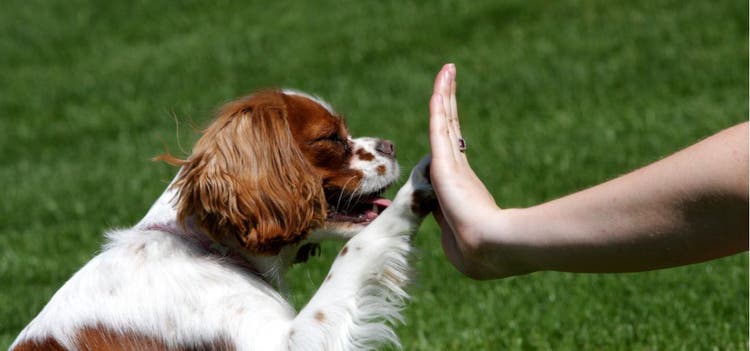
5 Benefits of Positive Reinforcement Dog Training
There’s no doubt about it — positive reinforcement training for dogs provides an excellent foundation for the development of a well-mannered canine.
There are many steps that owners can take at home to help shape behavior. The best approach to take is one that involves positively reinforcing desirable behaviors, so that training is an enjoyable experience for you and your dog.
That being said, if you are not in the right mood for training, don’t even start. When you are ready, keep training sessions short (5-10 minutes) to maintain your dog’s motivation.
If your dog doesn’t respond to a command after several attempts, don’t reward them. Resume training a few seconds later using a simpler command. Return to the more complex task later.
The benefits of positive behavior reinforcement are numerous and are well supported by scientific research. Here’s a look at the key benefits of positive reinforcement.
Key Elements of Dog Training with Positive Reinforcement
Positive behavior reinforcement involves the use of praise or a treat to reward a dog for exhibiting good or desirable behaviors. Positive reinforcement for a job well done is increasingly recommended over punishment or negative reinforcement to promote good behavior in both puppies and adult dogs.
The underlying principle of positive behavior reinforcement is to steer your focus away from negatively responding to attention-seeking behaviors and toward the development of positive behaviors.
Top 5 Benefits of Positive Behavior Reinforcement
Science Backs It
Scientific studies support the use of positive behavior reinforcement. Perhaps the best advantage of positive behavior reinforcement over other behavior shaping strategies is the many scientific studies that support the use of positive reinforcement. The field of animal behavior is constantly evolving, and research is increasingly supporting the effectiveness of positive reinforcement in shaping the behavior of dogs.
It Helps Build Confidence
Reinforcement of positive behaviors builds your dog’s confidence. Pups that are repeatedly punished for misbehaving can develop poor confidence and begin to suffer the effects of a broken spirit.
This is especially true if punishment repeatedly occurs without any rewarding from the dog’s family. Positive behavior reinforcement gives your dog’s confidence a boost by making them feel good about learning new behaviors. The result is a happier, more spirited animal that approaches learning with eagerness as opposed to fear.
The Whole Family Can Participate
The simplicity of positive behavior reinforcement enables your whole family to take part in rewarding your dog’s good behavior. Even children can learn how to spot desirable behaviors and reward your dog with praise or treats. In fact, children can learn a lot about the importance of displaying good behaviors when they participate in positive behavior reinforcement strategies.
It Combats Canine Fear
Positive behavior reinforcement helps prevent “freezing up” due to fear. Training methods that involve the use of punishment or negative reinforcement can cause your dog to freeze due to fear of engaging in a behavior that may be punished.
This can ultimately delay development and learning of positive behaviors. Because positive behavior reinforcement strategies only focus on rewarding your dog for exhibiting good behavior, the tendency to experience freezing or stage fright goes away.
Your Dog Will Start to Enjoy Training
Your dog will look forward to training sessions. They will also look forward to learning new commands and behaviors when positive behavior reinforcement is used in training. Whether the positive reinforcement arrives in the form of a treat, a click, and/or verbal praise, your dog will happily approach the learning process without fear.